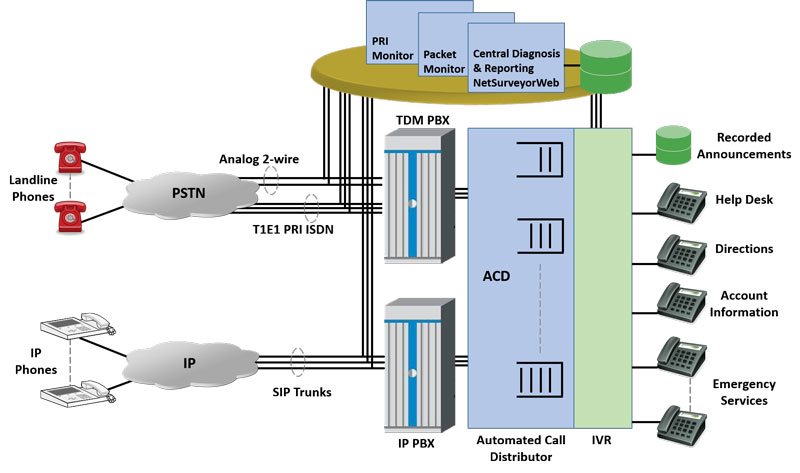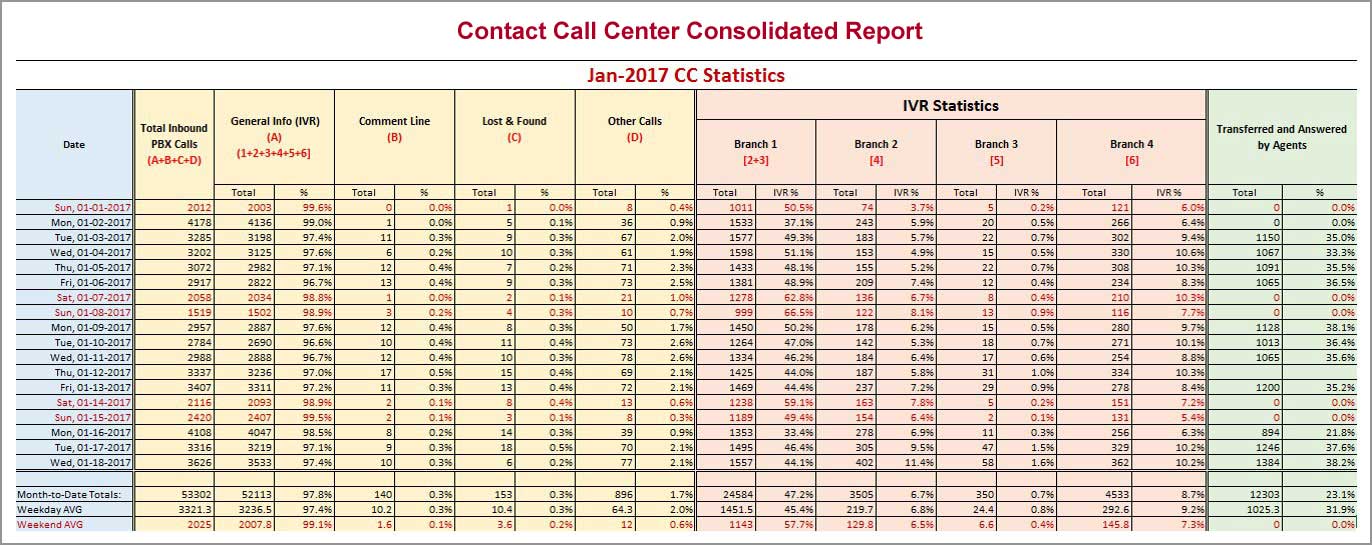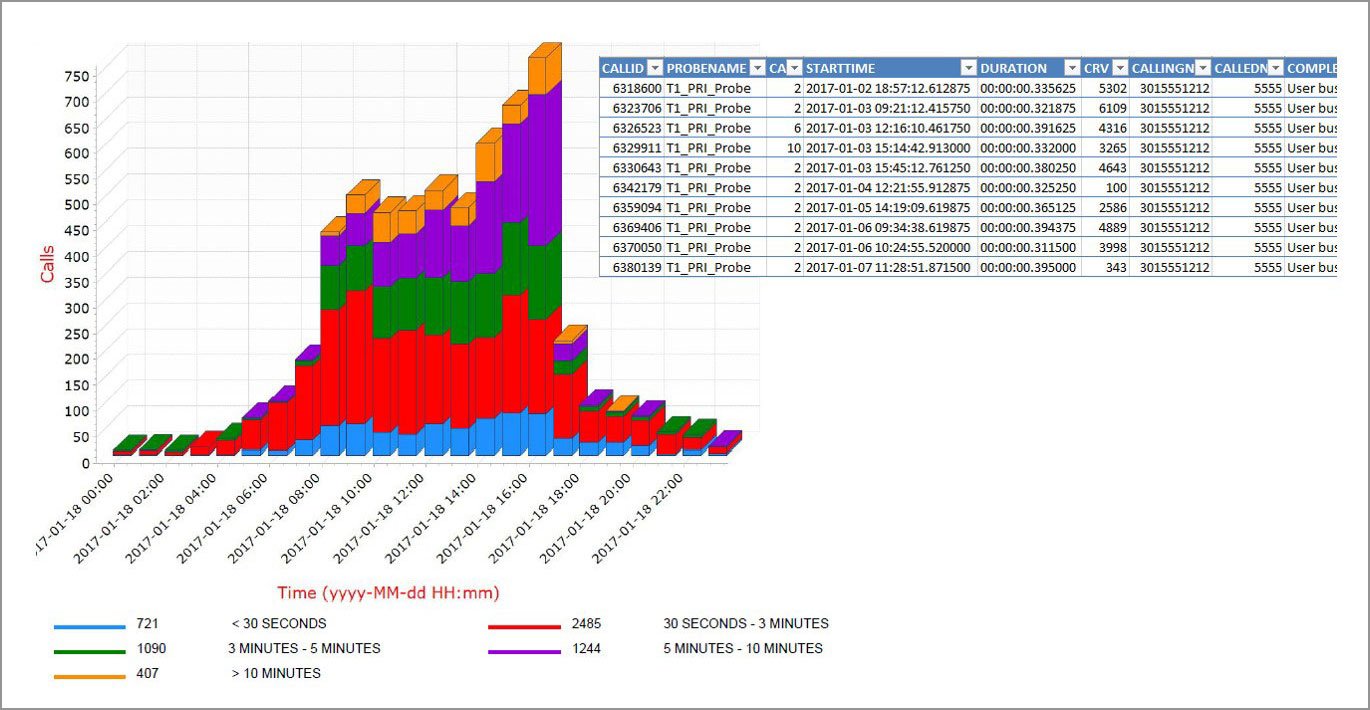Centralized Diagnostics and Reporting Systems
Welcome to another January 2019 issue of GL's newsletter. In this issue, we focus on solutions for Centralized Diagnostics and Reporting Systems typically used by Large Contact Centers, and Data Centers. Such a system can provide valuable information for optimizing resources such as trunk sizing, call distribution, IVR capacity, human attendants, and similar “expensive” resources.
This newsletter outlines a project performed recently for a prominent Maryland-based Contact Center, which utilized GL's expertise for evaluating call volumes, Interactive Voice Response (IVR) statistics as well as other contact center statistics. GL’s T1 E1 PRI Monitoring and NetSurveyorWeb™ system were customized and deployed to work with a commercial off-the-shelf (COTS) IVR System. The consolidated reporting helped to provide valuable information for cost effective trunk sizing, IVR capacity, number of human attendants, and recorded announcements.
Project Management Services and Monitoring Solutions
GL provided its expertise in project management and consulting services to meet customer’s requirement for an out-of-the-box monitoring and consolidated reporting solution. Multiple project stakeholder meetings were necessary to understand the relevant statistics included in the consolidated report.
Shown below is a typical network infrastructure at a contact center, consisting of T1 E1 PRI Trunks, SIP Trunks, IVR (Interactive Voice Response) System, Call Distribution (Queuing) and Attendants/Departments for Specific Services e.g. Recorded Announcements, Help Desk, Emergency Services, Directions, Account Information, etc.
Also shown, are:
- GL’s Passive (Non-Intrusive) T1 E1 PRI Monitoring System
- GL’s Passive (Non-Intrusive) Packet Voice Monitoring System
- Centralized Diagnosis and Reporting Tool - NetSurveyorWeb™ with Oracle DB
- NetSurveyorWeb™ to query other network elements such as IVR systems for consolidated reporting

At the center of the solution was GL’s NetSurveyorWeb™, a scalable and flexible architecture used in conjunction with GL’s Protocol Analyzer probes to non-intrusively monitor from a single or multiple testing locations. GL's protocol analysis probes feed data to a database in real-time for further analysis. The NetSurveyorWeb™ client application then locally or remotely facilitates viewing records from the database using a simple web browser application. It also provides easy integration with other reporting servers to generate custom reports as per user requirements.
GL developed a customized Query software for interrogating several other information systems to present a Consolidated Report for contact call center key statistics. GL acquired statistics from multiple application servers that provided important call, IVR and agent statistics. Information presented in this report was gathered from multiple locations, including GL’s analysis probes monitoring multiple carrier T1-PRIs. This project also involved developing a software application that interfaced through an Application Protocol Interface (API) to a Genesys Voice Platform based IVR.
The scope of the project included:
- Providing system engineering services to identify the statistical data required by the contact center stakeholders
- Providing a flexible architecture so that additions and modifications to the data extracted can be performed without future code changes
- Analyze and understand the existing reports that are generated by three different sources: Unify’s OpenScape Contact Center Server, the IVR Genesys Voice Platform Server, and GL’s T1-PRI monitoring equipment
- Develop the necessary mechanisms to collect and/or extract the statistical data required from each of the three sources mentioned above
- Consolidation of all statistical data and automatically e-mail to the stakeholders on a nightly and monthly basis
Shown below is a sample of the customized report generated as per customer requirements.

Sample Consolidated Report for Contact Center
Shown below is a set of reports generated for monitoring daily operations through call statistics, monitoring usage of trunks on a daily or weekly basis, and provide insight into overall performance.

Sample NetSurveyorWeb™ Report
GL’s Network Monitoring System - NetSurveyorWeb™
GL’s Network Monitoring and Diagnostic Systems are capable of collecting useful information from the network backbone to support various monitoring activities. The web-based applications facilitate display of Call Detail Records (CDRs) by connecting to TDM, Optical, or IP probes through a web server for monitoring physical layer status, signaling and traffic. Almost all Wireless (LTE, IMS, UMTS, GSM), VoIP (SIGTRAN, SIP, H.323, MAP, CAP, INAP), and TDM (SS7, ISDN, GSM, TRAU) protocols are supported.
Typical Applications
- Comprehensive analysis and reporting on overall network health to detailed protocol monitoring
- Continuous unlimited recording limited only by hard disk or network storage space
- Automatic “Event of Interest” detection and real-time alerting
- Call detail records, fraud detection and location, remote protocol analysis and troubleshooting, real-time signaling monitor, traffic optimization engineering, and statistics
- Actual call signaling route determination to verify network functionality under all situations including congestion and loss of connectivity
- Revenue and billing verification, alarm monitoring, intrusive testing
- Quality of service measurements call trace and recording
- Scalable architecture allows up to STM-4 rate per server
- Multiple servers can be stacked to increase call capturing capacity to 10's of thousands of calls
 Back to Newsletter Index Page
Back to Newsletter Index Page